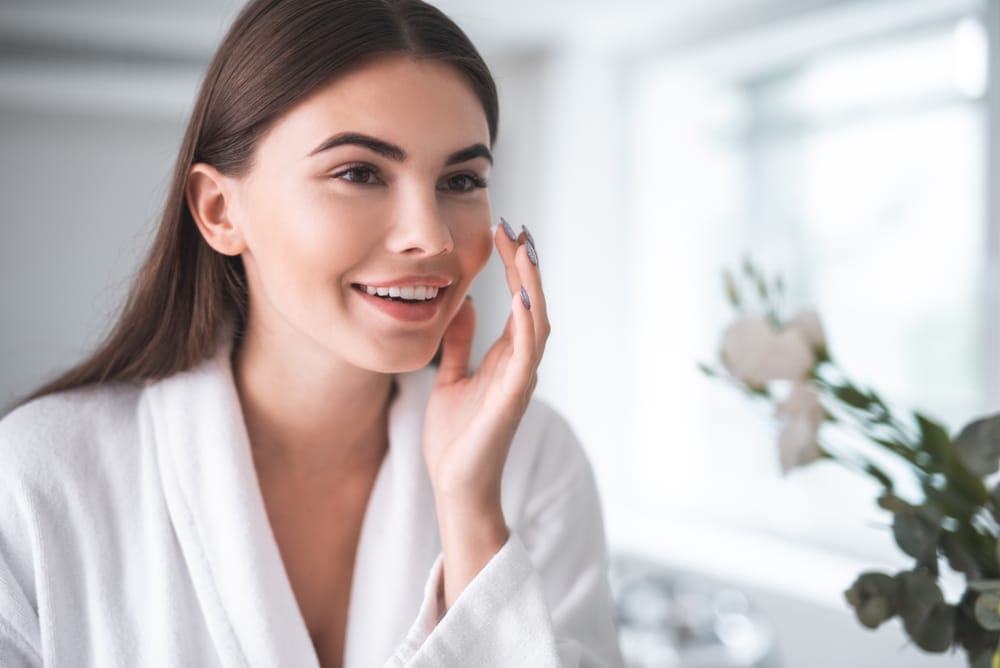Plump, full cheeks are often seen as a sign of youth and health. Unfortunately, as we age our skin loses elasticity and gives our face a sunken, hollow appearance. There are many reasons why someone may have hollow cheeks. One common cause is weight loss, which can leave the face looking gaunt. While some causes are within our control, others such as the natural aging process, are definitely not. There are a few different ways to treat hollow cheeks. If you’re concerned about the way your cheeks look, knowing your options can help you make the best decision for your needs. In this article, we’ll go over the causes of hollow cheeks and the different treatment options available.
Get your personalized
meal plan!
What Causes Cheek Hollows?
When you notice your cheeks looking hollow, it’s important to understand what may be causing the problem. There are a variety of factors that can contribute to sunken cheeks, including:
Aging
Your cheeks are made up of fat pads that help support the skin. As you age, these fat pads begin to shrink, which causes your cheeks to look sunken (5).
Aside from fat loss, the natural aging process also causes your skin to become thinner and less elastic. This makes any existing hollows in your cheeks more pronounced (5).
Collagen is a protein that helps keep your skin looking firm and plump. Unfortunately, as you age, your body produces less collagen, which may make your cheeks look hollow (7).
Rapid Or Extreme Weight Loss
Losing a significant amount of weight can cause your cheeks to look hollow. This is because when you lose weight, you also lose fat from your face (7).
If you’re considering losing a large amount of weight, it’s important to do so slowly and under the supervision of a doctor or registered dietitian. Losing weight too quickly can cause serious health complications, as well as unwanted side effects, such as hollow cheeks (7).
Dehydration
If you’re not getting enough fluids, your body can become dehydrated. This can cause your skin to look dry and sunken. Dehydration also makes any existing hollows in your cheeks more pronounced (7).
Read More: Face Exercises For Men Who Want A Defined Jawline
Certain Diseases And Conditions
There are a few diseases and conditions that may cause cheeks to look hollow. These include:
Autoimmune Diseases
Autoimmune diseases, such as lupus and Crohn’s disease, causes inflammation throughout the body. This leads to weight loss and a sunken appearance (2).
Cancer
Cancer treatments, such as chemotherapy and radiation, can cause weight loss and dehydration, which makes cheeks look hollow (1).
Anorexia Nervosa
This eating disorder is characterized by self-starvation and an intense fear of gaining weight. People with anorexia often have very thin faces, which gives the appearance of hollow cheeks (7).
Hypothyroidism
This condition occurs when your thyroid gland doesn’t produce enough of the hormone thyroxine. Thyroxine helps regulate your metabolism and affects many different systems in your body (4).
Hypothyroidism causes a variety of symptoms, including weight gain, fatigue, and dry skin. These symptoms all contribute to the appearance of hollow cheeks (4).
Genetics
Hollow cheeks can also be the result of genetics. If your parents or grandparents had hollow cheeks, you may be more likely to have them as well (7).
If you’ve mustered up the courage to crush your weight loss goal, let Betterme take the sting out of this demanding process. Our app will help you restructure your habits, remold your life and crank up your fitness results!
How Do You Fix Your Cheek Hollows?
There are multiple surgical and non-surgical options available for treating cheek hollows. The best option for you will depend on the cause of your hollow cheeks and your desired results.
Surgical Options
If you’re looking for a more dramatic change, you may want to consider a surgical procedure. Surgical procedures can provide long-lasting results, but they also come with a higher risk of complications.
Some of the most common surgical procedures used to treat cheek hollows include:
Cheeklift
A cheeklift, also known as a mid-face lift, is a surgical procedure that’s used to improve the appearance of the cheeks.
During a cheeklift, your surgeon will make incisions in your hairline and around your ears. They will then lift the skin and underlying tissue before repositioning it to fill in any hollows (3).
You’re a good candidate for a cheeklift if you:
- Are over the age of 30
- Have significant hollowing in your cheeks
- Don’t smoke
- Have realistic expectations for the results of surgery
- Are in good overall health
There are pros and cons to every surgical procedure. Some of the advantages of a cheeklift include (3):
- Long-lasting results
- Can be combined with other procedures, such as a facelift or eyelid surgery
- Relatively short recovery time
The disadvantages of a cheeklift include (3):
- Potential complications, such as infection, nerve damage, and bleeding
- Swelling and bruising
- Temporary numbness in the treated area
Before deciding on a cheeklift, be sure to discuss all of the risks and benefits with your surgeon.
Fat Grafting
Fat grafting is a surgical procedure that involves taking fat from another area of your body and injecting it into your cheeks. This can help add volume to your cheeks and improve their appearance (10).
You may be a good candidate for fat grafting if you:
The advantages of fat grafting include:
- Natural-looking results
- Potential for long-lasting results
- Minimally invasive procedure
- Can be used to correct asymmetry
Fat grafting is usually performed as an outpatient procedure using local anesthesia. This means you won’t need to stay in the hospital overnight. The surgery will take about 1-2 hours (10).
You may experience some swelling and bruising after the procedure. These side effects should resolve within a few weeks (10).
The results of fat grafting are usually long-lasting. However, it’s possible that some of the injected fat may be reabsorbed by your body over time (10). You may need to have additional procedures to maintain your results.
Read More: Why Am I Losing Weight In The Face: The Real Reason Behind It
Cheek Implants
Cheek implants are small, artificial pieces of silicone that are placed under the skin to add volume to the cheeks. The implants are placed through incisions made inside the mouth, so there will be no visible scars (8).
Recovery time is usually about two weeks. During this time, you may have some bruising and swelling, and you may feel some pain and numbness (8).
Cheek implants are a more permanent solution than fat grafting, as the implants will stay in place indefinitely (8).
Other advantages of cheek implants include:
- A more predictable result
- A quicker, easier surgery
- Minimal recovery time
Like any other surgical procedure, there are risks involved with cheek implants. These include infection, implant rejection, and nerve damage (8).
If you’re considering cheek implants, it’s important to consult with a board-certified plastic surgeon who has experience performing this procedure. They will be able to assess your individual case and determine whether or not implants are the right option for you.
Non-Surgical Treatments
Surgery isn’t the only way to treat hollow cheeks. There are a number of non-surgical options that can help improve the appearance of your cheeks without the need for an invasive procedure:
Injectable Fillers
Injectable fillers are a nonsurgical option for treating cheek hollows. Fillers can be injected into the cheeks to add volume and improve their appearance (8).
There are many different types of injectable fillers available, each made from different materials. The most common types of fillers used to treat cheek hollows are made from hyaluronic acid.
Hyaluronic acid is a substance that occurs naturally in the body. It helps to keep your skin hydrated and plump. When injected, it can help to fill in hollows and smooth out wrinkles (8).
The advantages of injectable fillers include:
- No surgery or anesthesia required
- Minimal recovery time
- Results can be seen immediately
- Can be used to target specific areas
Injectable fillers are a temporary solution for treating cheek hollows. The results will typically last for 6-12 months before the filler is slowly absorbed by your body (8). You may need to have repeat treatments to maintain your results.
There are a few risks associated with injectable fillers, such as bruising, swelling, and infection. However, these side effects are usually mild and temporary (8).
Consulting a board-certified plastic surgeon or dermatologist who has experience performing injectable fillers is the best way to ensure safety and optimal results.
Reasons why BetterMe is a safe bet: a wide range of calorie-blasting workouts, finger-licking recipes, 24/7 support, challenges that’ll keep you on your best game, and that just scratches the surface! Start using our app and watch the magic happen.
At-Home Treatments
There are a few at-home treatments that can help to improve the appearance of cheek hollows. These include:
Having A Hydrating Skin Care Routine
One of the best ways to improve the appearance of your skin is to keep it hydrated. Dry skin can accentuate the appearance of wrinkles and hollows.
To hydrate your skin, you need to use a gentle cleanser and a moisturizer that is appropriate for your skin type. You should also drink plenty of water throughout the day.
Using Topical Retinoids
Topical retinoids are a type of medication that is derived from vitamin A. They are available in over-the-counter and prescription formulations (6).
Topical retinoids can help to improve the appearance of your skin by increasing collagen production and decreasing the breakdown of existing collagen. They can also help to reduce the appearance of fine lines and wrinkles (6).
To use topical retinoids, you should apply a pea-sized amount to your face once daily, after cleansing. You may need to use them for several weeks or months to see a noticeable improvement in your skin.
Using A Guasha Tool
Guasha is a traditional Chinese medical technique that involves scraping and rubbing skin with a smooth, blunt tool. This is thought to improve circulation and promote healing (9).
To use a guasha tool, you should hold the tool against your skin and scrape-rub it in a way as directed by TCM. You can do this once or twice a week, as needed (9).
Start Exercising
Exercise can help to improve the appearance of your skin by increasing blood flow and stimulating collagen production. Aerobic exercise, such as walking, running, or swimming, is especially beneficial (7).
You should aim to get at least 30 minutes of exercise a day, 5 days a week (7). If you are new to exercise, you may need to start with shorter sessions and gradually increase the amount of time you’re exercising.
Eat Right
Your diet can also affect the appearance of your skin. Eating a healthy diet that includes plenty of fruits, vegetables, and lean protein can help to improve your skin’s elasticity and reduce the appearance of wrinkles (7).
You should also avoid foods that are high in sugar and unhealthy fats, as these can contribute to inflammation and make your skin more susceptible to damage (7).
The Bottom Line
Hollow cheeks can be caused by a number of factors, including aging, weight loss, and genetics. There are a few treatment options available, both surgical and non-surgical.
If you are concerned about the appearance of your cheeks, you should consult a board-certified plastic surgeon or dermatologist to discuss your options. They will be able to recommend the best treatment plan for you, based on your individual needs and goals.
At-home treatments, such as exercise, a healthy diet, and using a guasha tool, can also help to improve the appearance of your skin.
DISCLAIMER:
This article is intended for general informational purposes only and does not serve to address individual circumstances. It is not a substitute for professional advice or help and should not be relied on for making any kind of decision-making. Any action taken as a direct or indirect result of the information in this article is entirely at your own risk and is your sole responsibility.
BetterMe, its content staff, and its medical advisors accept no responsibility for inaccuracies, errors, misstatements, inconsistencies, or omissions and specifically disclaim any liability, loss or risk, personal, professional or otherwise, which may be incurred as a consequence, directly or indirectly, of the use and/or application of any content.
You should always seek the advice of your physician or other qualified health provider with any questions you may have regarding a medical condition or your specific situation. Never disregard professional medical advice or delay seeking it because of BetterMe content. If you suspect or think you may have a medical emergency, call your doctor.
SOURCES:
- A prospective analysis of factors that influence weight loss in patients undergoing radiotherapy (2014, nih.gov)
- Autoimmune Diseases (n.d., nih.gov)
- Face-lift (2020, mayoclinic.org)
- Hypothyroidism (2019, nih.gov)
- Management of Shrunken Cheeks by Hollow Buccal Cheek Plumper Prosthesis (2021, nih.gov)
- Retinoids in the treatment of skin aging: an overview of clinical efficacy and safety (2006, nih.gov)
- Sunken Cheeks: Causes, Symptoms & Treatments (n.d., cadoganclinic.com)
- Sunken Cheeks (n.d., phiclinic.com)
- The effect of Gua Sha treatment on the microcirculation of surface tissue: a pilot study in healthy subjects (2007, pubmed.gov)
- The science behind autologous fat grafting (2017, nih.gov)














